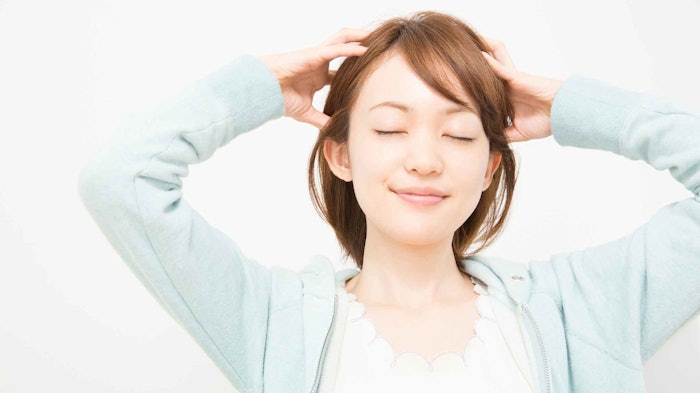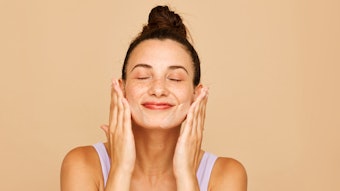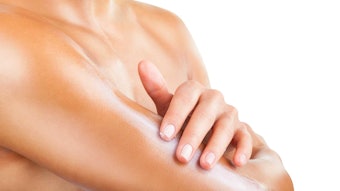
On many levels, the scalp is different from other parts of the body. It is unique in its high density of terminal hair growth and for its numerous sebaceous glands responsible for sebum production. These secretory glands, typically attached to hair follicles, release sebum into the infundibula via sebaceous ducts. The sebum further progresses to the skin surface and coats it to form a hydrophobic protective layer.
Log in to view the full article
On many levels, the scalp is different from other parts of the body. It is unique in its high density of terminal hair growth and for its numerous sebaceous glands responsible for sebum production. These secretory glands, typically attached to hair follicles, release sebum into the infundibula via sebaceous ducts. The sebum further progresses to the skin surface and coats it to form a hydrophobic protective layer.
The pilosebaceous units are also anatomically unique. These lipid-rich hydrophobic niches form particularly large tubular invaginations that extend from the skin surface and reach all the way down to the dermis and subcutaneous tissue. They are therefore areas of intensive communication with the external environment and harbor a large variety of microorganisms. The upper parts of these invaginations, in particular, are exposed to microorganisms and are sites of enhanced immune cell trafficking. Deeper down, immune-privileged sites crucial to hair follicle cycling and regeneration are found.
This substantial difference in conditions makes the pilosebaceous unit a structure highly susceptible to the development of various disorders. Depending on the specific microorganisms, their size and penetration depth, they can activate the sensitive immune-privileged sites and trigger inflammatory processes.
Cutibacterium acnes, for example, thrives in the sebum-rich microenvironment of the scalp and has been found to penetrate particularly deeply into the pilosebaceous unit.1 In individuals suffering from sensitivity, an overgrowth of C. acnes disrupts the balance of the scalp. The perturbed microbiome in these individuals, coupled with its impact on the inflammatory state of the scalp, is also closely associated with increased scalp sebum levels and the occurrence of scalp discomfort.
Since those afflicted have a lower threshold to over-reactivity, reactions are triggered by external and internal factors, e.g., pollution or UV irradiation, much earlier than in individuals with a normal scalp. While these triggers typically should not cause such reactions, they have harrowing effects on people with sensitive scalps, leading to sensations of itch, irritation, stinging and burning. Indeed, the scalp has emerged as one of the areas most affected by this sensitivity.2
Recognition of the significance of scalp health has surged in recent years, with brands extending skin care claims to shampoos, conditioners and other treatments. One noticeable trend over the last five years has been the steady increase in hair care product launches specifically designed for sensitive scalps, aligning with consumers' growing interest in health and wellness.3
Scalp health is intricately connected to overall well-being and comfort. Suffering from persistent or recurring scalp discomfort and even pain can profoundly impact one's emotional state and behavior. Disregarding such concerns not only compromises physical comfort, but also holds the potential to significantly diminish an individual's overall quality of life.4
Moreover, scalp health is deeply intertwined with hair health, a crucial aspect of personal appearance. Dealing with hair greasiness due to excessive sebum levels is one example of a persistent and daily struggle for those affected. Often misconstrued as a sign of neglect, hair greasiness substantially contributes to a sense of insecurity.
To counteract this, however, individuals find themselves caught in a "sebum rollercoaster.” Increased sebum production leads to a cyclical pattern of more frequent hair washing, driven by a fear of greasy hair and potential social judgment. Unfortunately, over-cleaning the hair, much like over-washing the skin, disturbs the microbiome, can induce inflammation and therefore cause the scalp to react with increased sebum production.
Breaking free from this vicious cycle proves to be a significant challenge, requiring a holistic approach that addresses both the observable and subjective aspects of the sensitive oily scalp condition. Responding to this, a Maclura cochinchinensis (cockspur thorn) extract was developed and tested in vitro and in vivo, as described here, for its potential to relieve sensitive scalp symptoms.
The ingredient had previously shown sebum-reducing activity, with successful results for acne reduction, anti-inflammation and regulation of the skin microbiome (described elsewhere). Prior in vivo metagenomic analysis of the facial skin microbiome also revealed the ingredient inhibited C. acnes growth after 28 days of application to the face (not shown). These results informed further studies to explore its effects on the scalp – aligning with the skinification of hair trend.
Described here are in vivo studies for the extract’s scalp soothing potential, carried out via self and expert grading, as well as its sebum control efficacy, measured instrumentally and through panelist-perceived and expert-evaluated hair regreasing rates. In vitro, the ingredient’s effects on the pro-inflammatory enzymes cyclooxygenase-1 and -2 and 5-lipoxygenase (COX-1, COX-2 and 5-LOX) were also measured to assess its anti-inflammatory capacity for the scalp. The goal was to develop an active to provide sensitive scalp relief by derailing multiple interconnected aspects of the sensitive scalp “rollercoaster” to provide the end user the opportunity to regain control and self-esteem.
Materials and Methods
Test active: A glycolic extract of M. cochinchinensisa, rich in prenylated bioflavonoids, was used as the active ingredient for the described tests.
Test formulas: A leave-on scalp tonic without (control) and with 1.0% test active was formulated, containing: water, xantham gum, gellan gum, sodium benzoate, potassium sorbate and citric acid. In addition, a rinse-off shampoo without (control) and with 0.5% and 1.0% test active was developed, including: water, sodium laureth sulfate, cocamidopropyl betaine, sodium chloride, sodium benzoate, citric acid and potassium sorbate.
In vivo protocols: The in vivo studies described conformed to the requirements of the 1964 Declaration of Helsinki and its subsequent amendments (World Medical Association; 2013). The participants signed a written subject consent form before any study procedures began.
In vivo scalp irritation: A double-blind, placebo-controlled, randomized in vivo study was performed using the scalp tonic formulation to assess the effects of the test active on scalp irritation. Subject selection was restricted to subjects classified as “stingers;” i.e., individuals who exhibited a pronounced response to the application of 10% lactic acid.
Ten subjects (five male and five female), ages 24 to 54 years (average 37.6), applied either the placebo or the active formulation twice daily on their scalp for 14 days. At baseline and Day 14, a half-side test was performed with 10% lactic acid and deionized water with subsequent scalp sensory rating. Expert grading entailed the assessment of redness and visible scalp irritation, while the subject self-perception questionnaire covered the parameters of stinging, irritation, itchiness and discomfort.
In vivo sebum regulation: A separate in vivo study was carried out to determine the potential sebum-regulating efficacy of the test active used in the previously described rinse-off shampoo. The test was performed in a double-blind and randomized manner and examined whether a single use of the test active decelerated the hair regreasing rate, and whether two months of test product use reduced sebum levels.
Forty-one subjects (30 female and 11 male; ages 19-67 years: average 43.1 years) having moderate to very heavy greasiness on the forehead and hair were included. The subjects underwent a one-week washout phase during which the placebo shampoo (0% active) was used every second day. After this, the subjects used a formulation with either 0.5% or 1.0% test active every second day for 56 days.
Scalp sebum measurements were takenb and hair’s greasiness was determined by self-assessment and expert grading at Day 0 (between the wash-out phase and the application phase); at Day 28; and at Day 56. At these time points, the first measurement was taken 48 hr after the subject’s last hair wash/test product use. The subjects' hair was washed with the test product and a second measurement was taken immediately following; a last measurement was taken 4 hr later.
In vitro anti-inflammatory effects: An additional in vitro study was conducted to investigate the potential anti-inflammatory effects of the active. The inhibition of the key enzymes involved in inflammatory pathways was measured through a fluorimetric assay on human recombinantly produced COX-1, COX-2 and 5-LOX.
For COX-1 and COX-2, the detection molecule used was 10-acetyl-3,7-dihydroxyphenoxazine (ADHP). Arachidonic acid is converted by COX-1 and COX-2 into prostaglandin G2 (PGG2). The peroxidase reaction between PGG2 and ADHP is also catalyzed by the COX enzymes and produces the highly fluorescent compound resorufin from supplemented dihydroresofurin, which is analyzed with an excitation wavelength of 530-540 nm and an emission wavelength of 585-595 nm.5
For the determination of 5-LOX activity, the fluorescent probe rhodamine-123 was used in a similar way as described for the COX enzymes. 5-LOX converts arachidonic acid into leukotriene A4 (LTA4) with an intermediate peroxidation step, where the fluorescent rhodamine-123 is produced from dihydrorhodamine-123.6
Statistical values were determined with paired student's t-test or Wilcoxon signed rank test, dependent on applicability. Reported values in black are the result of comparison with baseline (paired) and in blue are the result of comparison with placebo (unpaired).
Results
Scalp irritation: Application of the M. cochinchinensis extract significantly improved all evaluated sensory parameters, compared to both baseline and placebo. After 14 days, the self-assessed parameters of stinging, irritation, itch and discomfort improved by 67%, 100%, 91% and 100% respectively (see Figure 1, below). In addition, expert clinical grading revealed an 83% improvement in both redness and visible scalp irritation (not shown). In total, sensory ratings after applying the test scalp tonic for 14 days accounted for an overall improvement of 82%. Conversely, within the placebo group, scalp sensory ratings deteriorated compared with baseline – with the exception of the "itchiness" rating.
Sebum production: The application of 0.5% and 1.0% concentrations of the test active ingredient in a rinse-off shampoo significantly reduced sebum levels by 25.1% and 40% after 56 days of use (see Figure 2, below). Notably, significant sebum reduction was observed with the 1% concentration after 28 days of use. Hair washing with the active ingredient therefore provided the dose- and time-dependent regulation of scalp sebum levels.
In relation, according to subjects' self-assessments, the use of 0.5% and 1.0% concentrations of the test active for 56 days resulted in a significant reduction in hair greasiness – by 18% and 25%, respectively (see Figure 3, below). Thus, the dose- and time-dependent reduction of sebum previously detected was also observed by the subjects, who noted the improvement hair oiliness.
Notably, improvements in hair sebum were perceived with 1.0% test active after only 28 days of use. Furthermore, expert assessments of hair greasiness showed significant 20% and 13% reductions, compared with the placebo, with 0.5% and 1.0% test active formulations after 56 days of product application (see Figure 4, below).
Inflammatory enzymes: Key enzymes involved in both pathways of inflammatory mediator generation from arachidonic acid – i.e., COX-1, COX-2 and 5-LOX – were significantly inhibited by 0.1% of the test active in the described assay at levels ranging from 71% and 91% (see Figure 5, below).
Discussion
Scalp sensitivity poses a significant struggle for those affected, impacting not only their physical comfort, but also their emotional well-being. The heightened reactivity of a sensitive scalp often manifests in symptoms such as itch, redness and discomfort, potentially influencing overall quality of life.
In addition, the overproduction of sebum, a common consequence of scalp sensitivity, results in greasy hair, which can affect self-confidence and lead to concerns about appearance and social judgment. These symptoms are also recurring in nature and can therefore create a chronic and distressing experience for individuals. This further emphasizes the struggle associated with scalp sensitivity, including observed disruptions in the scalp microbiome.1, 2
Responding to this, the M. cochinchinensis extract developed and tested here showed efficacy on various processes involved in scalp sensitivity and sebum production. The in vitro inhibition of the COX-1, COX-2 and 5-LOX enzymes, which are involved in inflammatory processes, provides the fundament for the soothing efficacy shown in vivo.
All parameters assessed in scalp sensory ratings, including "itchiness” – which is reportedly the most common discomfort parameter – drastically improved within two weeks of the test scalp tonic application. This perceptible aspect is crucial, as feelings of scalp discomfort are a central complaint as well as a parameter used for diagnosis in self-assessments and questionnaires.2 Improving the user’s quality of life by providing gentle care for scalp sensitivity is therefore a core property of the test active.
In addition, increased sebum levels were identified as a measurable parameter for sensitive scalp and key target to treat this condition.2 The sebum-reducing effects of the rinse-off formula described here, with the test active at concentrations as low as 0.5%, clearly conferred this efficacy. The measured dose- and time-dependent improvements in sebum levels were complemented by the users’ observed dose-dependent reductions in scalp regreasing rate.
The results suggest the active could be used effectively in oil control formulations for the scalp and hair. Expert assessments also confirmed the slowed regreasing rate was visible to an external eye.
In previous work (detailed elsewhere), the M. cochinchinensis test active also selectively targeted C. acnes, an entity associated with an imbalanced scalp microbiome. Indeed, this microorganism has been shown to overgrow in conditions provided by sensitive oily scalps but its growth was inhibited by the test active at a concentration below 1.0% – without impacting the growth of Staphylococcus epidermidis, an entity typically desirable for healthy skin flora (see Figure 6, below). Thus, the active could potentially restore balance to the scalp microbiome.2
Caring for the scalp is essential for maintaining healthy hair. In fact, research has demonstrated that recurring problems of excessive scalp sebum can contribute to hair loss further down the line.7 The understanding of this intricate connection between scalp health and hair condition has significantly evolved in recent years, prompting individuals to incorporate scalp care into their beauty routines.3 The industry has undoubtedly entered a "crown care” era, where solutions such as the M. cochinchinensis extract described offers a holistic solution to relieve sensitive scalps.
Conclusion
The M. cochinchinensis extract described here holds the potential to provide potent and holistic relief for sensitive oily scalps by addressing perceptible disruptions and verifiable parameters associated with the condition. The active could play a pivotal role to enhance users’ quality of life thanks to its soothing properties.
As the landscape of hair care shifts toward a "crown care” era, characterized by the increased understanding that hair’s overall condition is rooted in scalp health, the struggles associated with scalp sensitivity – which affects nearly 50% of the population8 – will finally receive the attention they deserve.
a Scalpinist-Senso (INCI: Propanediol (and) Bioflavonoids), Rahn AG
b Sebumeter, Courage & Khazaka
References
1. Polak-Witka, K., Rudnicka, L., Blume-Peytavi, U and Vogt, A. (2020). The role of the microbiome in scalp hair follicle biology and disease. Exp Dermatol, 29(3) 286-294.
2. Ma, L., Guichard, A., Cheng, Y., Li, J., Qin, O., Wang, X., Liu, W. and Tan, Y. (2018, Aug 6). Sensitive scalp is associated with excessive sebum and perturbed microbiome. J Cosmet Dermatol. Available at https://pubmed.ncbi.nlm.nih.gov/30084158/
3. Mintel. (Accessed 2024, Apr 4). Re-post: Scalp care is increasing. Mibelle Biochemistry. Available at https://mibellebiochemistry.com/re-post-scalp-care-increasing.
4. Souza, E.N., Anzai, A., Costa Fechine, C.O., Sakai, Valente, N.Y. and Romiti, R. (2023). Sensitive scalp and trichodynia: Epidemiology, etiopathogenesis, diagnosis and management. Skin Appendage Disord, 9(6) 407-415.
5. Vanachayangkul, P. and Tolleson, W.H. (2012) Inhibition of heme peroxidases by melamine. Enzyme Res, 1-7.
6. Pufahl, R.A., Kasten, T.P., ... Weinberg, R.A., et al. (2007). Development of a fluorescence-based enzyme assay of human 5-lipoxygenase. Anal Biochem, (364) 204-212.
7. English, R.S., Jr. (2018). A hypothetical pathogenesis model for androgenic alopecia: Clarifying the dihydrotestosterone paradox and rate-limiting recovery factors. Med Hypotheses, (111) 73-81.
8. Misery, L., Halioua, B., ... Taieb, C., et al. (2024), Perceived prevalence of a sensitive scalp: A worldwide study. J Eur Acad Dermatol Venereol, 38: e191-e192.











